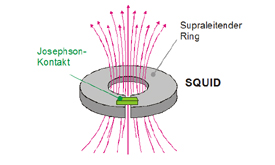
 Using Superconductivity we can design the world most sensitive sensors, so called SQUIDs. Squid is commonly known as a group of marine cephalopods with eight arms and two tentacles but in the following we will use it as the acronoym for (Superconducting Quantum Interference Device). Every SQUID consists of a macroscopic superconducting loop with one or two weak links (Josephson Junctions). When cooled below the critical temperature the magnetic flux will be trapped in the loop. The super current (isupra) causes the magnetic flux to be a multiple of the fluxoid Φ0. When Φ0 changes the superconductor adapts isupra to compensate the total flux. Now the weak link comes into play. Isupra can not compensate large changes in the external magnetic Φextern. When the critical current IC of the weak link is surpassed superconductivity break down locally and a flux quantum can enter or leave the superconducting ring. This crossover happens instantly and is accompanied by energy dissipation because the weak link is in a resisitive state. This dissipation can be accounted for very sensitively. This is the basic concept of a SQUID sensor.
Using Superconductivity we can design the world most sensitive sensors, so called SQUIDs. Squid is commonly known as a group of marine cephalopods with eight arms and two tentacles but in the following we will use it as the acronoym for (Superconducting Quantum Interference Device). Every SQUID consists of a macroscopic superconducting loop with one or two weak links (Josephson Junctions). When cooled below the critical temperature the magnetic flux will be trapped in the loop. The super current (isupra) causes the magnetic flux to be a multiple of the fluxoid Φ0. When Φ0 changes the superconductor adapts isupra to compensate the total flux. Now the weak link comes into play. Isupra can not compensate large changes in the external magnetic Φextern. When the critical current IC of the weak link is surpassed superconductivity break down locally and a flux quantum can enter or leave the superconducting ring. This crossover happens instantly and is accompanied by energy dissipation because the weak link is in a resisitive state. This dissipation can be accounted for very sensitively. This is the basic concept of a SQUID sensor.
Supracon AG
An der Lehmgrube 11
07751 Jena
Germany
Tel.: +49-3641-2328100
Fax.: +49-3641-2328109
info@supracon.com